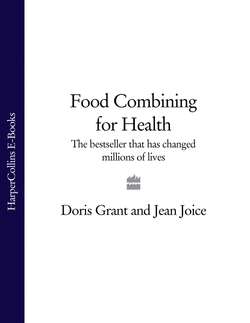Читать книгу Food Combining for Health: The bestseller that has changed millions of lives - Doris Grant - Страница 14
CHAPTER TWO The Hay System Explained
ОглавлениеThere is nothing so powerful as an idea whose time has come.
The Hay system consists of five important rules:
1 Starches and sugars should not be eaten with proteins and acid fruits at the same meal.
2 Vegetables, salads and fruits should form the major part of the diet.
3 Proteins, starches and fats should be eaten in small quantities.
4 Only whole-grain and unprocessed starches should be used, and all refined processed foods should be taboo – in particular, white flour and sugar and all foods made with them, and highly processed fats such as margarine.
5 An interval of at least four to four-and-a-half hours should elapse between meals of different character.
The cardinal rule of the Hay system – not mixing carbohydrates (i.e., starches and sugars) with proteins and acid fruits – is generally misunderstood, although based on sound physiological principles long existing and long forgotten. In order to understand this rule it is therefore necessary to explain the classification of carbohydrates and proteins in the context of compatible food combinations:
The proteins are concentrated (20 per cent or more) animal proteins such as meat, fish, cheese and poultry.
The carbohydrates are concentrated (20 per cent or more) starches, such as grains, bread and cereals, potatoes; and sugars.
Misunderstanding regarding this classification has been the main reason why many investigators have dismissed the starch – protein concept as being without foundation. The main argument put forward to refute this concept is that nature herself combines proteins and starches in most foods; that if it is wrong to combine these dissimilar elements at the same meal then nature herself is in error.
On first glance this argument would seem to be unanswerable; it is widely acknowledged that nature does not make mistakes.
On second glance this argument reveals shallow thinking; nature does not combine in one food a high concentration of protein (as in meat) with a high concentration of starch (as in grains). Although meats do contain carbohydrate, this is in the form of glycogen which requires little, if any, digestion, and its presence therefore does not interfere with the conditions necessary for protein digestion. Similarly, although grains contain about 10 per cent protein, this is incomplete in character, and is not in a concentrated form (as in meat); its presence therefore does not interfere with the conditions necessary for starch digestion.
Apart from the single exception of the mature, or dried, legumes – peas, beans, lentils and peanuts – nature combines starches and proteins in the same food in a form and in proportions which digest together perfectly, and in such a way, also, that the food is either predominantly starch or predominantly protein. The dried legumes are ‘the exception which proves the rule’; they contain too high a percentage of both protein and starch to be compatible in themselves (but become compatible and highly beneficial when sprouted – see Part Two). People who are accustomed to their habitual consumption over a long period can build up a tolerance to them just as they can build up a tolerance, for example, to smoking. But people who are not accustomed to them usually experience discomfort – and very audible protests from their digestive organs!
